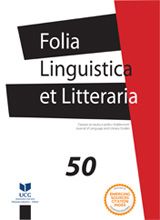NOUVEAUTES LEXICALES DANS LA LANGUE FRANÇAISE DES MEDIAS : CAS DES NEOLOGISMES DANS LA PRESSE ELECTRONIQUE
LEXICAL INNOVATIONS IN THE FRENCH MEDIA LANGUAGE: CASE OF NEOLOGISMS IN THE ELECTRONIC PRESS
Author(s): Tijana Matović, Olivera VušovićSubject(s): Language and Literature Studies, Semiotics / Semiology, Communication studies, French Literature, Phraseology
Published by: Filološki fakultet, Nikšić
Keywords: neologism; French language; French press; thematic domain; mechanism of creation; Dictionary of the French Academy
Summary/Abstract: Words illustrate the stages through which both society and language pass. Newly created words represent an unavoidable part of the everyday communication. They arise due to societal, technological and cultural changes. Several authors (Granić 2006, Filipan-Žignić 2012, Abd Elnabi Isa 2017, Župarić- Aničić 2019, Grbavac 2020) point out that the language of the media is increasingly evolving, especially on the lexical plan. Abbreviated forms and borrowings from English are gradually invading our daily communication. The aim of this paper is to analyze lexical innovations in the French media language, more precisely, to explore the case of neologisms used in the electronic press. Our intention is to analyze neologisms from the electronic versions of teenage magazine Phosphore and the daily newspapers 20 minutes and France Soir, collected in the period March-December 2023. As Sablayrolles notes, possible inclusion of a new word in a dictionary should take more or less time. However, this does not prevent the media from circulating lexical innovations. In that regard, our objective is to detect current lexical trends in the French media language, i.e. to answer the following questions: In which thematic areas do new words appear and to what extent? What are the most productive mechanisms for creating neologisms? Does the French language rely on its internal resources or does it resort to external resources, namely borrowings, and to what extent? First, we establish an overview of the theoretical framework of neology. Second, we present the corpus and methodology of our study. Third, we analyze and discuss the results, before ending with some final thoughts and future perspectives. The results obtained from the analysis of the neological corpus will help us to better understand the current lexical trends in French. Before analyzing new lexical units issued from the French press, we made a brief parenthesis regarding the definitions, main typologies and mechanisms of creation. There are various definitions of neology and neologism. Bouzidi defines neology as “the set of processes that determine the formation of new words, neologisms” (19). He considers it as a natural tendency that follows linguistic evolution, since “all languages adopt and introduce new words in order to follow the inevitable changes in society and the surrounding environment” (24). Coming from the Greek neos and logos, neologism represents “a new word or meaning that has emerged following the process of lexico-semantic renewal: neology” (Bouzidi 19). Similarly, according to Revilla Garcia, “neologism is a new lexeme formed to designate an object, a concept, a process or a new or recently created phenomenon that depends on collective judgments” (7−8). Niklas-Salminen adds an additional criterion for a word to be called a neologism: it is necessary that “a group of speakers experience, when faced with a given word, a feeling of novelty. The neologism must also spread in the community” (141 in Revilla Garcia 8). With regard to the typology of neologisms, in general, the main distinction is established between unit of new form and unit of new meaning. Abd Elnabi Isa also includes a third type – borrowings from other languages. As several authors recall (Filipović 1986 in Čunović 2015, Popović 2009, Dincă 2009, Abd Elnabi Isa 2017), there are three main processes of lexical enrichment. First, formation of new words from existing elements, i.e. affixal derivation, non-affixal derivation (conversion, truncation, initialisms and acronyms) and composition. Second, assigning a new meaning to an already existing form (semantic neologism) and third, borrowings from other languages. Pruvost and Sablayrolles (in Cartier et al. 3) propose a typology of lexicogenic matrices, processes for forming neologisms, comprising two main mechanisms: the internal matrix and the external matrix. While the second relates to borrowings, the first implies four groups: morpho-semantic mechanisms – modification by construction (affixation and composition), by imitation and deformation, syntactic-semantic mechanisms – change of function (for example, conversion) and change of meaning (metaphor, metonymy, other figure), morphological mechanisms – reduction of form (truncation, creation of initialisms and acronyms) and phraseological mechanisms. Our attention has been directed to the neologisms issued from French press published in 2023. After the initial collecting of new lexical units, the main criterion according to which we have filtered the neologisms was the lexicographic criterion, namely the presence of their form or meaning in the ninth edition of the Dictionary of the French Academy. Let us recall that, for centuries, the French Academy has played the role of the “defender” of the French language. This institution keeps maintaining the purity of French linguistic and cultural values and protects the linguistic treasure. Therefore, it is “an indispensable reference for everything related to the standard of French” (Souffi 156). The Dictionary of the French Academy is freely available to the general public and it “enjoys an international reputation, an unparalleled unitary historical dimension, and contains exceptional philological qualities” (Souffi 156). Given that the ninth edition of the Dictionary is still being completed, our sample of neologisms does not claim to be exhaustive.
Journal: Folia Linguistica et Litteraria
- Issue Year: 2025
- Issue No: 50
- Page Range: 152-177
- Page Count: 26
- Language: French

